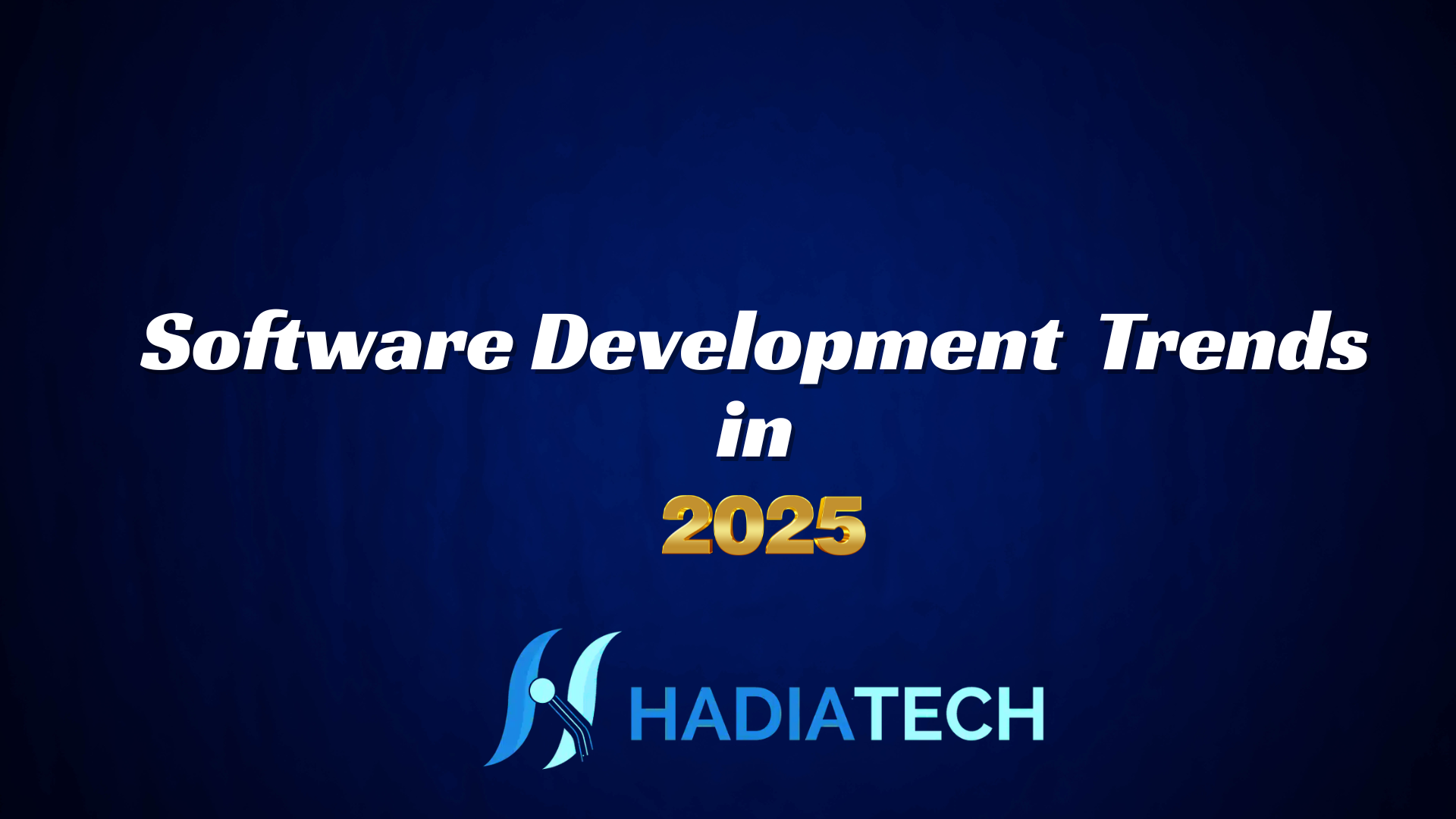Software Development Trends in 2025: What’s Actually Happening (and Why You Should Care)
Software Development Trends: Okay, so you know how tech is always moving, right? Like, blink for a second and suddenly there’s a new framework, a new app, or some new tool everyone swears is a game-changer. Well, that’s exactly what’s happening in software development right now.
2025 isn’t just more of the same. It’s like someone hit the turbo button. If you’re a developer, a designer, a startup founder, or even just someone trying to figure out where the tech world is heading, you’re gonna want to keep reading.
So grab your coffee (or chai if you’re like me), and let’s break down what’s really going on.

AI Isn’t Just a Buzzword Anymore – It’s the Co-Pilot
Let’s just get this one out of the way. AI is literally everywhere right now. But here’s the kicker . it’s no longer just some fancy feature or experimental tool. It’s becoming a core part of the development workflow.
Take GitHub Copilot, for instance. A couple of years ago, people were still testing the waters with it. But in 2025? Developers are practically pairing with AI as a co-worker. You’re writing a function, and bam . AI suggests the whole logic. You need to convert some legacy code? AI’s got your back.
But it goes deeper than that. Whole projects are now being scaffolded using AI tools. From generating UI components to creating backend routes and even writing unit tests . yeah, AI is doing that too.
Here’s the twist though: AI’s not replacing devs. It’s just speeding them up. Think of it like autocorrect for code, but on steroids.
Also Read: Let’s Talk About AI Tools
Low-Code Isn’t “Cheating” Anymore
Remember when using Wix or Shopify felt like you were somehow less of a “real” developer? Yeah, those days are over.
Low-code and no-code platforms have seriously leveled up. Tools like Bubble, Webflow, and even backend stuff like Xano are giving people the power to ship products without touching a single line of code.
But here’s what’s different now: Developers are embracing low-code, not avoiding it. They’re using it to prototype faster, launch MVPs quicker, and focus on the core stuff that actually needs custom code.
It’s not about replacing devs. It’s about saving time and focusing on what really matters. Because let’s be real . no one wants to spend three days building a login page anymore.
The Stack Is Getting… Weird (But in a Cool Way)
Okay, let’s talk tech stacks. They used to be kinda predictable. A few years ago, it was like: React for frontend, Node for backend, MongoDB or Postgres for data. Boom. Done.
But now? People are experimenting like never before.
You’ve got SvelteKit gaining serious traction because it’s super lightweight and fast. Bun is showing up as a lightning-fast alternative to Node. And Edge Functions . think serverless but closer to the user — are becoming the go-to for performance-focused apps.
Everything’s shifting toward being faster, leaner, and closer to the edge. It’s like the entire dev world got tired of heavy apps and said, “Let’s trim the fat.”
And if you haven’t heard of HTMX yet . yeah, you’re gonna. It’s like going back to old-school HTML, but in a futuristic way. Weird combo, but it works.
Also Read: Top Digital Marketing Agencies in Pakistan You Need to Know in 2025
Security Is Getting Personal
You know how every other week there’s some giant company leaking passwords or data? People are tired of it. And developers are now being expected to care more . not just slap on some basic auth and call it a day.
In 2025, security is baked into the dev process from day one. Think zero-trust architecture, passwordless logins, and biometric authentication even in smaller apps.
If you’re building anything today and not thinking about security from the first commit, you’re already behind. And trust me, users are starting to notice. They care now especially Gen Z, who are way more privacy-aware than people give them credit for.

Real-Time Everything Is the New Norm
Static websites? Still cool. But users want more now. They expect apps to update in real-time. Comments, chats, likes, stock prices, crypto dashboards whatever the app is doing, people don’t want to hit refresh to see updates.
This is why WebSockets, server-sent events, and tools like Supabase, Ably, and Pusher are blowing up. Real-time used to be “nice to have.” Now it’s table stakes.
Even if you’re building a personal project, the expectation is there. Real-time interactivity feels modern and people love modern.
Devs Are Designers Now (Kinda)
This one might sound weird, but hear me out. The line between developer and designer is getting blurry.
Tools like Figma are now deeply connected to code. Plugins literally export UI straight into React components. There are devs who are now designing their UIs in Figma and just plugging that into their codebase and it works.
Also, with tailwind-based UI kits, component libraries, and atomic design systems, devs are creating slick, clean interfaces without needing to ping a designer every time they need a button.
It’s not about replacing designers. It’s about speaking the same language. The better you understand layout, color, spacing the more in control you are of the final product.
Remote Dev Teams? That’s Just “Normal” Now
If you’re still thinking remote work is temporary, you’re not paying attention.
In 2025, remote development teams are the default. It’s not even called “remote work” anymore it’s just “work.” Period.
Companies are building tools, workflows, and documentation around this new reality. Tools like Linear, Notion, Loom, and Tuple are making collaboration smoother than ever. Daily standups happen on Slack. Pair programming happens over Zoom. Whiteboarding happens on Miro.
You could be working on a dev team with someone in Pakistan, someone in Berlin, and another guy from Brazil and it’s no big deal. This is just how stuff gets built now.
Sustainable Code is Hot (and Necessary)
Here’s something no one was talking about five years ago the carbon footprint of code.
Now? It’s on everyone’s radar. Devs are learning that bloated code, overuse of APIs, unnecessary re-renders, or even heavy images contribute to more energy use on servers.
So, what’s the move? People are optimizing for speed and sustainability. That means leaner frontends, smarter backends, caching like a pro, and actually caring about performance beyond just “it works”.
It’s not just a feel-good thing. Users bounce from slow sites. And companies are watching their cloud bills. Clean code = cheaper, greener, faster.
So, What Does It All Mean for You?
If you’re a dev or planning to be one here’s the deal:
You don’t have to chase every trend. Seriously. That’s the fastest path to burnout.
But you do need to stay aware. The landscape is changing, fast.
That doesn’t mean you need to master every new framework, but knowing what’s possible helps you make better choices.
And if you’re just someone trying to hire devs or start something new, understand that the game has changed.
The people building products today aren’t locked in cubicles writing C++ in the dark. They’re collaborating across time zones, working with AI, and shipping products in days not months.
One Last Thought
We’re in a time where software development is more human than ever. It’s faster, smarter, more collaborative and honestly, more fun. The tools are better, the support is stronger, and the entry barrier has dropped.
If you’ve been sitting on a product idea, now’s the time. Whether you’re using AI, no-code, or working with a team of devs, building something real has never been more doable.
And hey if you need help building a slick, modern, high-performing site or brand?
Let’s just say some of the best people in the digital world are doing exactly that right now.
FAQs
Is software development a good career in 2025?
Absolutely. With AI, automation, and digital platforms booming, skilled developers are more in demand than ever. Whether it’s building apps, maintaining cloud systems, or working with AI tools, devs are at the center of it all.
Which best describes a recent trend in software development?
The rise of AI-assisted coding and low-code platforms is one of the biggest shifts. Developers are using AI as co-pilots and leveraging tools that make building apps faster and more accessible.
What is the software architecture trend in 2025?
Microservices and serverless architectures are dominating. There’s also a growing focus on edge computing — running parts of the app closer to the user for speed and better performance.
What is the software market in 2025?
The global software market is massive and still growing. Enterprise software, SaaS products, AI-powered tools, and cybersecurity solutions are leading the charge across industries.
Which technology is best in 2025?
It depends on the use case, but AI integration tools, edge computing, low-code platforms, and modern frontend frameworks like Svelte and Next.js are among the hottest technologies right now.
What is the developer demand in 2025?
High and rising. From AI engineers to full-stack devs and cloud specialists, companies are constantly looking for talent that can build, scale, and secure digital products.




